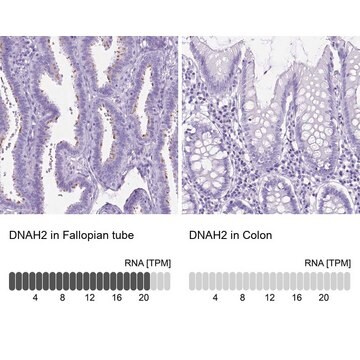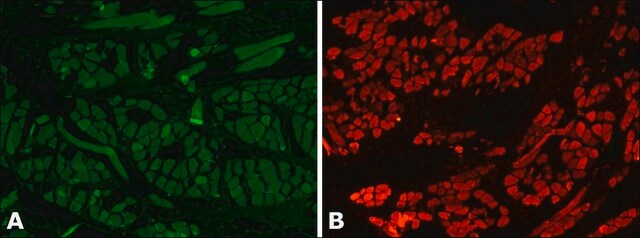推荐产品
生物源
rabbit
共軛
unconjugated
抗體表格
affinity isolated antibody
抗體產品種類
primary antibodies
無性繁殖
polyclonal
形狀
buffered aqueous solution
分子量
antigen ~34 kDa
物種活性
human, rat, mouse
技術
immunohistochemistry (formalin-fixed, paraffin-embedded sections): 1:3,000 using protease-digested sections of human and mouse skeletal muscle.
western blot: 1:1,000 using extract of E. coli expressing UCP3
UniProt登錄號
運輸包裝
dry ice
儲存溫度
−20°C
目標翻譯後修改
unmodified
基因資訊
human ... UCP3(7352)
mouse ... Ucp3(22229)
rat ... Ucp3(25708)
一般說明
Anti-Uncoupling Protein 3 (UCP3) is developed in rabbit using a synthetic peptide corresponding to amino acid residues 254-267 of human UCP3, with N-terminal lysine added, conjugated to keyhole limpet hemocyanin (KLH). The uncoupling proteins (UCPs) are mitochondrial inner membrane proteins which comprises UCP1, 2, 3, 4 and 5. UCP3 displays two forms, a long mature, UCP3L and a short, UCP3S form. UCP3 is preferentially expressed in skeletal muscle and in brown adipose tissue (BAT).
UCP3 is a skeletal muscle protein that functions to uncouple mitochondrial respiration from ATP production. UCP3 regulates fatty acid and energy metabolism. This protein inhibits lipid-induced oxidative stress in the mitochondrial components of heart and skeletal muscle cells. UCP3 may also be involved in the pathogenesis of type 2 diabetes . Anti-UCP-3 antibody is specific for UCP3 in humans, rats and mice and does not react with UCP1 and UCP2. Staining of the UCP3 band by immunoblotting is specifically inhibited with the immunizing peptide.
免疫原
The corresponding sequence in rat and mouse UCP3 differ by 4 and 3 amino acids, respectively.
synthetic peptide corresponding to human UCP-3 sequence (amino acids 254-267) with N-terminal lysine added, conjugated to KLH.
應用
Anti-UCP-3 antibody is suitable for use in immunohistochemistry (formalin-fixed, paraffin-embedded sections at 1:3,000 dilution, using protease-digested sections of human and mouse skeletal muscle). The antibody may also be used in immunoblot (approx. 34 kDa, additional weak bands may be detected in some preparations of brown adipose tissue extracts) and western blot (at 1:1,000 dilution, extract of E. coli expressing UCP3).
Anti-UCP-3 antibody produced in rabbit has been used in immunohistochemistry and western blotting.
生化/生理作用
The uncoupling proteins (UCPs) are considered as transporters functioning as enzymatic uncouplers of oxidative phosphorylation. They are capable of returning protons pumped by the respiratory chain to the mitochondrial matrix. UCP3 is an active proton transporter, regulated by CoQ (ubiquinone), fatty acids or nucleotides.
外觀
Solution in 0.01 M phosphate buffered saline, pH 7.4, containing 1% BSA and 15 mM sodium azide
免責聲明
Unless otherwise stated in our catalog or other company documentation accompanying the product(s), our products are intended for research use only and are not to be used for any other purpose, which includes but is not limited to, unauthorized commercial uses, in vitro diagnostic uses, ex vivo or in vivo therapeutic uses or any type of consumption or application to humans or animals.
未找到合适的产品?
试试我们的产品选型工具.
儲存類別代碼
12 - Non Combustible Liquids
水污染物質分類(WGK)
WGK 2
閃點(°F)
Not applicable
閃點(°C)
Not applicable
Ana Isabel Padrão et al.
Biochimica et biophysica acta, 1822(8), 1189-1197 (2012-05-01)
Hyperglycaemia-related mitochondrial impairment is suggested as a contributor to skeletal muscle dysfunction. Aiming a better understanding of the molecular mechanisms that underlie mitochondrial dysfunction in type 1 diabetic skeletal muscle, the role of the protein quality control system in mitochondria
The mitochondrial uncoupling proteins
Ledesma A, et al.
Genome Biology, 3(12), reviews3015-reviews3011 (2002)
Age-associated declines in mitochondrial biogenesis and protein quality control factors are minimized by exercise training
Koltai E, et al.
American Journal of Physiology. Regulatory, Integrative and Comparative Physiology, 303(2), R127-R134 (2012)
Patrick Schrauwen et al.
The Proceedings of the Nutrition Society, 62(3), 635-643 (2003-12-25)
Physical activity influences energy metabolism in human subjects by increasing activity-induced energy expenditure and resting metabolic rate for several hours after exercise. On the other hand, physical activity increases mechanical energy efficiency, suggesting that trained subjects would need less energy
The on-off switches of the mitochondrial uncoupling proteins
Azzu V and Brand MD
Trends in Biochemical Sciences, 35(5), 298-307 (2010)
我们的科学家团队拥有各种研究领域经验,包括生命科学、材料科学、化学合成、色谱、分析及许多其他领域.
联系技术服务部门








